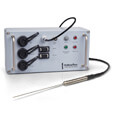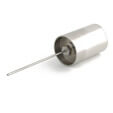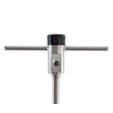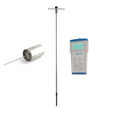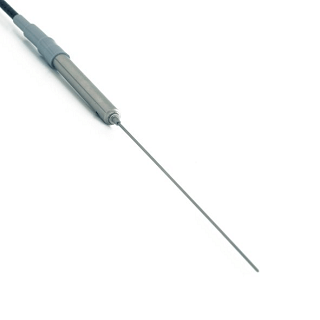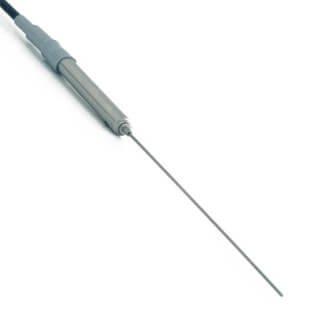How to measure soil thermal conductivity?
Soil thermal conductivity is a property that influences heat transfer. Engineers and scientists frequently consider soil thermal conductivity when designing underground structures, evaluating energy transfer in the ground, or investigating heat flow in the earth's crust.
This article provides an overview of soil thermal conductivity and its various aspects. First, we explain what soil thermal conductivity is. Second, we discuss how it can be measured using needle probes. Third, we dive into the different applications of soil thermal conductivity measuring systems. Next, we present the measuring systems offered by Hukseflux. Finally, we outline the expectations to consider when measuring soil thermal conductivity.
What is soil thermal conductivity?
Fourier's law relates the heat flux φ through a material to its thermal conductivity λ, the temperature difference between two points ΔT, and the distance between those points Δx:
![]()
To illustrate this, let us consider a rod with a length of Δx. One side of the rod is kept at a temperature T1, while the other is kept at a lower temperature T2. Therefore, there will be a heat flow from hot to cold through the material. The proportionality constant between the heat flux and the temperature gradient is what we call thermal conductivity.
In other words, we use soil thermal conductivity to express how easily heat can flow through soils. This depends on factors such as mineral type, particle size, amount of organic matter, water content, and bulk density. Different soil types have different thermal conductivities; dry, sandy soil typically has lower conductivity than moist or clay-rich soil.
Soil thermal resistivity is the reciprocal of soil thermal conductivity. It represents the ability of a material to resist the flow of heat.
Measuring thermal conductivity with needle probes
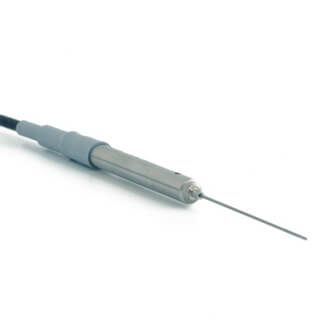
thermal conductivity measurement.
The thermal conductivity of soil can be measured experimentally using thermal needle probes. An example of a needle probe is the Hukseflux TP08, as shown in Figure 1.
Thermal needle probes, or non-steady state probes, typically contain one or more temperature sensors. The needle includes a linear heater that runs along the length of the needle. Moreover, it has a known electrical resistance per unit length.
The needle can be inserted into the soil. When the heater is switched on, the temperature will start to rise. If you heat more, then the temperature will rise more quickly. The heater power per meter that is generated by the probe can be accurately measured using Joule’s law:
![]()
where
• Q is the heater power (W/m)
• RL is the heater’s electrical resistance per unit length (Ω/m)
• I is the heater current (A)
Once the heater power is measured, the data can be analysed to determine the thermal conductivity.
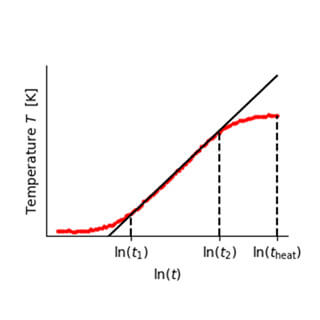
logarithm of time. From the slope of the middle section,
the thermal conductivity of a soil can be extracted.
To illustrate this, let us consider the temperature curve as a function of the logarithm of time, as depicted in Figure 2. The curve can be split up into roughly three sections.
The first section, to the left of ln(t1), is the transient portion of the curve. Here, the effects of the heating of the needle can be seen. In the middle section, between ln(t1) and ln(t2), the logarithm of time rises linearly with the temperature. This is known as the quasi-steady state part and is used to determine the thermal conductivity. The last section, between ln(t2) and ln(theat), is dominated by the end effects of the probe.
In the middle section, the temperature only depends on the heater power and the thermal conductivity. The slope can be determined by using the following formula: ![]()
From this, the thermal conductivity of the material can be calculated using the formula:
![]()
Complications
When measuring with a needle probe, there are a few things you need to watch out for:
- The temperature of the specimen should be stable before the probe's heating starts.
- The probe must be adequately fixed so that it does not move during the measurement. If the object moves, it may cause sudden temperature fluctuations in the graph.
- The probe should be in good thermal contact with the material of interest. In other words, make sure that there is no air gap between the needle and the material.
Applications
Soil thermal conductivity measurements with a sensor are essential for two significant applications.
First, for high voltage power cables that are buried underground. The cables must be kept cool to prevent degradation. If they exceed a temperature of 80 degrees Celsius, degradation begins. Therefore, it is necessary to measure the properties of the soil and calculate the cooling effect. The better the soil conducts, the better the heat generated by the current is dissipated.
Second, soil thermal conductivity measurements are essential for oil pipelines. Oil is a viscous fluid that needs to be pumped. It is usually heated to attain a lower viscosity. For this reason, oil pipelines are typically insulated. Therefore, the soil contributes to the insulation of the oil pipeline, whether it is buried underground or on the sea floor. In this application, it is beneficial if the soil does not conduct heat very well, contributing to better insulation.
Measuring soil properties can be cost-saving for both applications. In high-voltage power cables, copper is an expensive material. If more heat can be generated, the copper diameter can be reduced. The same thing applies to oil pipelines. Additional insulation material must not be used if the soil insulates well.
Measuring systems offered by Hukseflux
Hukseflux provides advanced systems designed to measure the thermal conductivity of soils accurately.
Table 1 Soil thermal conductivity measuring systems offered by Hukseflux.
TPSYS20 is a high-accuracy system that measures thermal conductivity using TP02 or TP08 thermal needle probes. It is ideal for analysing soils, sediments, paints, glues, and highly viscous fluids. The TPSYS20 is particularly suitable for thermal conductivity measurements in a laboratory environment.
The MTN02 is a system used for measuring soil's thermal conductivity and resistivity. It is primarily designed for indoor laboratory measurements but can also be used for on-site field measurements. The MTN02 is operated and powered through the handheld control and readout unit, CRU02, making it a convenient and efficient tool for soil analysis.
The FTN02 Field Thermal Needle System is a device that performs precise on-site measurements of the soil's thermal resistivity and thermal conductivity. It is designed explicitly for surveys that need to measure from the surface to a depth of 1.5 meters. The FTN02 is operated and powered through the handheld control and readout unit, CRU02.
The TNS02 system accurately measures soil's thermal conductivity and resistivity in the field and laboratory. It combines the FTN02 and MTN02 systems. The system includes two needles, one for use in the laboratory on a short insertion tool and the other on a long lance for on-site measurements. The control and readout unit, CRU02, is shared between the two needle models.
What to expect from thermal conductivity measurements?
Numerous factors make thermal conductivity measurements hard to perform, but not impossible. Therefore, it is important to keep some things in mind:
- Do not be surprised if repeatability is bad. This has multiple reasons.
First, there are many possibilities for experimental errors. For example, if the soil is not entirely dry before taking a measurement, heating with the needle probe might cause local evaporation of water. This leads to an error in the result. Second, the dependence on moisture content is very strong. It is wrong to assume that the soil moisture content is the same in the entire sample. From one depth to another, there might be a dramatic change in soil moisture content. Finally, the interpretation of the signal is difficult. Looking for the slope of the linear part of your graph, as done in Figure 2, is a manual job. - It is not easy to claim high accuracy in soil measurement. An accuracy between 3% and 10% is a good result.
- Measure the soil at both extremes: completely dry or completely saturated. This makes the sample more homogeneous.
We recommend checking out our products' user manuals if you're interested in learning more about thermal conductivity measuring systems. At Hukseflux, we're always available to help you find the best measuring system for your measurements. If you have any further questions, please don't hesitate to contact us.








